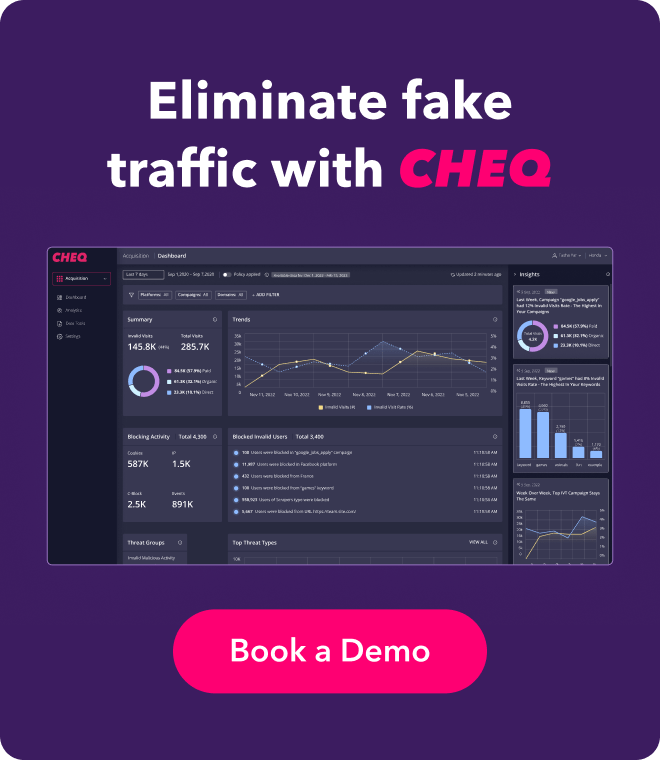How Bots Impact the Auto Industry
Jonathan Marciano
|Marketing | May 18, 2021

As one of the most valuable things people own (after their houses or apartments), it stands to reason that the automotive industry spends a lot on acquiring customers online.
In fact, in the US in 2019, the auto industry spent $13.3 billion on digital advertising. This figure dropped to just under $11 billion in 2020, thanks mostly to the coronavirus pandemic, but is forecast to return to over $13 billion in 2021.
However, as the sector roars back to life and embraces new digital opportunities for online customer acquisition, automotive leaders are finding themselves facing a new challenge: customer acquisition fraud.
To understand this problem of bots and fake users infesting automotive sales funnels, it is first important to analyze how the automotive industry is increasingly moving to digital customer acquisition.
The rapid rise of digital automotive customer acquisition
Marketers and consumers were used for decades to splashy car ads of cresting mountain peaks or fast rides down exotic city streets in big-scale TV spots. In contrast, there was reluctance to move towards an online experience because much of the car sales process involved trying to get buyers into the dealership. COVID-19 intensified the auto industry’s embrace of eCommerce and began at scale using digital advertising customer acquisition, including search, Facebook, LinkedIn, or Pinterest as a platform for new car sales or after sales.
Tesla, of course, has accustomed customers to buying cars entirely online, and many others in digital customer acquisition are catching up. Then things really changed. Like in other sectors, COVID-19 has been rocket fuel for the industry’s digital and eCommerce efforts. For instance, during COVID-19, GM’s “Shop. Click. Drive” program, a seven-year-old initiative, reported a spike of up to four times normal levels.
Toyota advertised its 2021 Sienna on Pinterest to capture new users. Honda’s compact sedan received its debut on Twitch, an Amazon-owned video game-streaming platform, where 67 percent of viewers are under 35. Nissan USA CMO Allyson Witherspoon has also revealed the success of Facebook Live campaigns for the brand in a brave bid to attract new users into the funnel during COVID-19. Some 90% of Audi’s sales now start online, while BMW is planning to invest hundreds of millions of euros every year until 2025 to digitize its sales and marketing operations.
CHEQ for PPC is the first solution to block invalid clicks and eliminate fake users across multiple platforms, including Google, Facebook, Instagram, Baidu, Bing, LinkedIn, Snap, Twitter, Pinterest, Yahoo, and Yandex. As such, we have had a front-row seat during this rapid rise in spending on such channels in the auto industry (and the challenge of battling invalid clicks) in the move to digital. The push to digital customer acquisition spend has created a major growth opportunity, “meeting customers where they are” in the words of Witherspoon. Volvo Car UK consumer director Nicole Melillo Shaw says, “What we want to do is make sure that we are agile and flexible enough to meet those demands of consumers; however, they want to interact with Volvo.”
But at the same time, the rise in new channels has also created a far wider surface attack for bot-driven bad actors. The effects of all this increased bot activity and invalid clicks are starting to be felt by digital marketers and demand generation leaders in several ways.
How big is customer acquisition fraud?
So, just how big is the problem of bots and fake users in auto-customer campaigns? How are they actually infesting campaigns? At CHEQ for PPC, we see 3% of invalid clicks across paid digital customer acquisition for automotive brands. To be clear, this reflects completely invalid clicks of users who are not real (cannot drive) and will never buy a car. The problem involves sophisticated attacks against popular and expensive creative campaigns.
What techniques do bots use to disrupt automotive customer acquisition?
Bots drive junk through brand funnels using methods including VPNs, data center traffic, scraping, and click fraud.
In the cases of automotive sites for big car brands across hundreds of campaigns analyzed, 37% of all fraud seen on the top site originated from data centers. The weaponization of data center traffic plays a large part in the rise of customer acquisition fraud. Data centers are popular among bot operators because they represent an easy and relatively inexpensive way to hide illegal activity, with some services that offer the usage of thousands of IP addresses for a few dozen dollars. Fraudsters route their bots through data centers (proxy services) in order to “change” their IP in an attempt to avoid detection. In addition, 12% of the crawlers rolling onto the automotive website early were malicious: scraping information, copying content from the site in order to host it elsewhere, and depleting ad budgets (before CHEQ blocking was enacted).
Though this amounts to millions of dollars of wasted targeting on non-customers (and non-humans), this leaking of fuel is by no means the biggest challenge.
The larger effects include everything from long-term missing out on revenues to damaging customer experiences.
1. Lost revenue opportunities from fake auto customers
Lost revenue opportunities occur when a company makes less from operations than expected due to fake or bot users. Traditionally, revenue loss projections involve long-term thinking about new regulations or drops in demand – for instance, global chip shortage in the case of the car sector. However, invisible and unforeseen are the opportunities lost through fake users and bots filling funnels. The net effect is that automotive companies are leaving money on the table by capturing bot attention instead of real eyeballs. While online dealerships can expect a $50,000 lifetime value from loyal customers, fake users swept up from these campaigns deliver zero revenue and zero lifetime value. If this spend was invested in real customers the revenue opportunities stand to be in the millions of dollars in a tight fight for new drivers. “They’re in a very low-margin business, and they need to be efficient in order to be able to turn a profit,” says Jeremy Anspach, CEO of dealership digital advertising vendor PureCars.
2. Distorting data relied upon by decision-makers
Data is now considered the “oil” of customer acquisition. However, bots overheat the engine by skewing vital marketing and unit economics. In the words of one senior executive in automotive manufacturing: “We do not have any real insight into the true performance of the Wild West that still defines our top-of-the-funnel media spend. We spend a huge amount on media, and at least 20% is unaccounted for.” This data is vital in performance marketing campaigns but can be skewed. Nissan, for instance, adopts a strategy of identifying where upper and lower-funnel conversions have a long-term higher likelihood of leading to an eventual purchase. This is a bid to “optimize two sets of users at different points in the customer journey,” according to Anouar Zaiane, Search Director at Nissan United Europe.
However, many visits on auto sites are a result of click fraud, bots, or invalid clicks. This means that much of the data relied upon turns out to be useless and dangerous. Follow-on actions from this include wasting remarketing dollars and building lookalike audiences based on bot audiences.
Fixing bot on chatbot action for auto brands
The skewing of data includes organic chat, designed to talk to buyers, which is wasted on chatting with fellow bots. Many leading brands have adopted chatbots in the last decade, starting with Ford and Vauxhall. In addition, auto marketing teams have doubled down on analysis-based Martech, such as Hotjar, Drift, and Unbounce. Despite their best intentions, bot visits mean these tools bring back flawed “customer engagement” data. If 10% to 30% of the time (invalid bot activity tends to rise for organic traffic), these applications find themselves serving their widgets to bots. This brings home the wrong data and the wrong conclusions to the desks of marketers.
3. Fake bot reviews
Bots also work in other sneaky ways. The average new car buyer engages with an average of 24 research or review touchpoints along their journey, according to Dealerwebb. Carwow, Europe’s largest new car marketplace with up to 80m views a month, also reports a massive shift in users seeking third-party reviews (rather than manufacturers branded content). In a recent report, CHEQ revealed that the direct influence of fake reviews on US e-commerce reached $28 billion in 2021, with automotive sites increasingly affected. Part of the fake online review problem has been a resurgence of bot-filled reviews. Increasingly, these land through customer acquisition campaigns. Bots enter review pages and fill in reviews, effectively hurting auto sites by undermining their reputation.
4. Fake form fills
In addition, tens of thousands of form fills (most often seeking a call or setting up a test drive) are bot-driven. This involves temporary emails being used by fraudsters. Here, bots run by ad fraudsters end up “converting” into a lead by filling in details on a form (name, email address, phone number). If no email verification is required, the fraudster has no reason to use a real address and can just send random ones. If email verification is required, the fraudster controls the email addresses which he inputs. This can be done in various ways; the fraudster buys bulk addresses, which redirects every email to an email address the fraudster controls.
5. Draining budgets early in the morning
We also see bots (before CHEQ blocks invalid clicks) putting their foot down and clicking on ads to drain budgets. By draining the budgets of an advertiser early in the morning, this effectively puts auto brands out of commission for getting real customers that day. In fact, we see that bots in the automotive sector tend to click on ads at 7 am (at the local time a customer should be viewing, clicking, or filling). By contrast, the lowest rate of bot attacks in the auto industry is 11 pm.
6. Fixing traffic signals delivered to Facebook and Google
Finally, Facebook and Google are motivated to get advertisers the best results for their campaigns. To reach new customers, brands are reliant on these channels to work effectively (Facebook and Google have a combined market share of 57% of US advertising, so they can capture a lot of car buyers). The way it works is that pixels, such as on car sites, tell these advertising giants which users engage the most, prompting a call for “lookalikes” to ask for more of these “good” visitors to the site. However, with millions of invalid clicks, brands are inadvertently transmitting the wrong information about leads, hampering paid platforms’ ability to parcel out the best audiences. This hurts organic and paid marketing results in the long term.
What is customer acquisition security?
Customer acquisition security is the means used by marketing and revenue leaders to eliminate the fast-growing problem of fake users and bots from customers’ funnels, campaigns, analytics, and CRM.
For instance, teams use CAS to legitimize the clicks on their advertisements across all platforms by identifying and filtering out fraudulent clicks. This adds millions of dollars in new revenue and ensures more predictable data and numbers for marketing, analytics, operations, and revenue leaders.
Conclusion
The challenges of bots and fake users come at a time when the battle for customer acquisition is facing its biggest challenges as auto spend ignites again. Media agency Dentsu predicts that automotive advertising is set to grow at nearly 14% from -24% growth in 2020, as carmakers look to encourage more consumers back after a challenging year in which the top 20 global manufacturers saw profits decline by approximately $100 billion.
Each lost click or impression is one less genuine user who can become a customer. For automotive dealers or car brands looking to get the most bang for their buck in the aftermath of 2020, the elimination of bots and fake users has the potential to rev up revenue figures.
CHEQ is the leader in customer acquisition security. CHEQ for PPC is a security suite for the CMO, digital teams, and demand generation leader to track bots and fraudulent activity from all major search engines and social media platforms using cybersecurity technology. CHEQ for PPC is the first solution to block invalid clicks across multiple platforms, including Google, Facebook, Instagram, Baidu, Bing, LinkedIn, Snap, Twitter, Pinterest, Yahoo, Yandex, and more. Get your free demo here.













